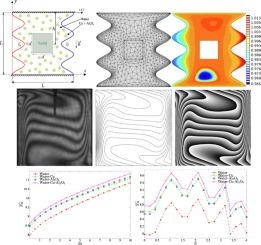Journal of Advanced Research ( IF 11.4 ) Pub Date : 2020-09-28 , DOI: 10.1016/j.jare.2020.09.008 Ammar I Alsabery 1, 2 , Tahar Tayebi 3, 4 , Hakim T Kadhim 5 , Mohammad Ghalambaz 6, 7 , Ishak Hashim 2 , Ali J Chamkha 8, 9

|
Introduction:
Mixed convection flow and heat transfer within various cavities including lid-driven walls has many engineering applications. Investigation of such a problem is important in enhancing the performance of the cooling of electric, electronic and nuclear devices and controlling the fluid flow and heat exchange of the solar thermal operations and thermal storage.
Objectives:
The main aim of this fundamental investigation is to examine the influence of a two-phase hybrid nanofluid approach on mixed convection characteristics including the consequences of varying Richardson number, number of oscillations, nanoparticle volume fraction, and dimensionless length and dimensionless position of the solid obstacle.
Methods:
The migration of composite hybrid nanoparticles due to the nano-scale forces of the Brownian motion and thermophoresis was taken into account. There is an inner block near the middle of the enclosure, which contributes toward the flow, heat, and mass transfer. The top lid cover wall of the enclosure is allowed to move which induces a mixed convection flow. The impact of the migration of hybrid nanoparticles with regard to heat transfer is also conveyed in the conservation of energy. The governing equations are molded into the non-dimensional pattern and then explained using the finite element technique. The effect of various non-dimensional parameters such as the volume fraction of nanoparticles, the wave number of walls, and the Richardson number on the heat transfer and the concentration distribution of nanoparticles are examined. Various case studies for Al2O3-Cu/water hybrid nanofluids are performed.
Results:
The results reveal that the temperature gradient could induce a notable concentration variation in the enclosure.
Conclusion:
The location of the solid block and undulation of surfaces are valuable in the control of the heat transfer and the concentration distribution of the composite nanoparticles.
中文翻译:

两相混合纳米流体方法对具有局部固体块的波浪盖驱动腔内混合对流的影响
介绍:
包括盖子驱动壁在内的各种空腔内的混合对流和热传递具有许多工程应用。研究这一问题对于提高电气、电子和核设备的冷却性能以及控制太阳能热操作和储热的流体流动和热交换具有重要意义。
目标:
这项基本研究的主要目的是检查两相混合纳米流体方法对混合对流特性的影响,包括变化的理查森数、振荡次数、纳米粒子体积分数以及固体障碍物的无量纲长度和无量纲位置的影响.
方法:
考虑了由于布朗运动和热泳的纳米级力引起的复合杂化纳米粒子的迁移。外壳中间附近有一个内部块,有助于流动、传热和传质。允许外壳的顶盖盖壁移动,从而引起混合对流。混合纳米粒子迁移对传热的影响也体现在能量守恒中。控制方程被塑造成无量纲模式,然后使用有限元技术进行解释。研究了各种无量纲参数如纳米粒子的体积分数、壁的波数和理查森数对传热和纳米粒子浓度分布的影响。进行2 O 3 -Cu/水混合纳米流体。
结果:
结果表明,温度梯度可以引起外壳中显着的浓度变化。
结论:
固体块的位置和表面的起伏对于控制传热和复合纳米粒子的浓度分布很有价值。











































 京公网安备 11010802027423号
京公网安备 11010802027423号